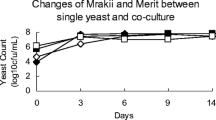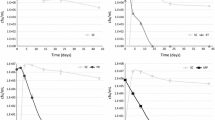Abstract
The effect of pure and mixed fermentation by Saccharomyces cerevisiae and Hanseniaspora valbyensis on the formation of major volatile components in cider was investigated. When the interaction between yeast strains of S. cerevisiae and H. valbyensis was studied, it was found that the two strains each affected the cell growth of the other upon inoculation of S. cerevisiae during growth of H. valbyensis. The effects of pure and mixed cultures of S. cerevisiae and H. valbyensis on alcohol fermentation and major volatile compound formation in cider were assessed. S. cerevisiae showed a conversion of sugar to alcohol of 11.5%, while H. valbyensis produced alcohol with a conversion not exceeding 6%. Higher concentrations of ethyl acetate and phenethyl acetate were obtained with H. valbyensis, and higher concentrations of isoamyl alcohol and isobutyl were formed by S. cerevisiae. Consequently, a combination of these two yeast species in sequential fermentation was used to increase the concentration of ethyl esters by 7.41–20.96%, and to decrease the alcohol concentration by 25.06–51.38%. Efficient control of the formation of volatile compounds was achieved by adjusting the inoculation time of the two yeasts.


Similar content being viewed by others
References
Bilbao A, Irastorza A, Duenas M, Fernandez K (1997) The effect of temperature on the growth of strains of Kloeckera apiculata and Saccharomyces cerevisiae in apple juice fermentation. Lett Appl Microbiol 24:37–39
Fleet GH (2003) Yeast interactions and wine flavor. Int J Food Microbiol 86:11–22
Hansen EH, Nissen P, Sommer P, Nielsen JC, Arneborg N (2001) The effect of oxygen on the survival of non-Saccharomyces yeasts during mixed culture fermentations of grape juice with Saccharomyces cerevisiae. J Appl Microbiol 91:541–547
Heard GM, Fleet GH (1985) Growth of natural yeast flora during the fermentation of inoculated wines. Appl Environ Microbiol 50:727–728
Heard GM, Fleet GH (1986) Occurrence and growth of yeast species during the fermentation of some Australian wines. Food Technol Aust 38:22–25
Heard GM, Fleet GH (1988) The effects of temperature and pH on the growth of yeast species during the fermentation of grape juice. J Appl Bacteriol 65:23–28
Henschke P (1997) Wine yeast. In: Zimmerman FK, Entian KD (eds) Yeasts sugar metabolism, biochemistry, genetics, biotechnology and application. Technomic, Lancaster, UK, pp 527–560
Herrero M, Roza C, García LA, Díaz M (1999) Simultaneous and sequential fermentations with yeast and lactic acid bacteria in apple juice. J Ind Microbiol Biotechnol 22:48–51
Jarvis B, Forster MJ, Kinsella WP (1995) Factors affecting the development of cider flavour. J Appl Bacteriol Symp Suppl 79:5S–18S
Laplace JM, Apery S, Frere J, Auffray Y (1998) Incidence of indigenous microbial flora from utensils and surrounding air in traditional French cider making. J Inst Brew 104:71–74
Lea AGH (1995) Cider making. In: Lea AGH, Piggott JR (eds) Fermented beverage production. Blackie, London, pp 66–67
Mora J, Barbas JI, Mulet A (1990) Growth of yeast species during the fermentation of musts inoculated with Kluyveromyces thermotolerans and Saccharomyces cerevisiae. Am J Enol Vitic 41:156–159
Morrissey WF, Davenport B, Querol A, Dobson ADW (2004) The role of indigenous yeasts in traditional Irish cider fermentations. J Appl Microbiol 97:647–655
Ough CS, Amerine MA (1988) Methods for analysis of must and wines. Wiley, Davis, CA
Rojas V, Gil JV, Pinaga F, Manzanares P (2003) Acetate ester formation in wine by mixed cultures in laboratory fermentations. Int J Food Microbiol 86:181–188
Romano P, Fiore C, Paraggio M, Caruso M, Capece A (2003) Function of yeast species and strains in wine flavour. Int J Food Microbiol 86:169–180
Swaffield CH, Scott JA, Jarvis B (1997) Observations on the microbial ecology of traditional alcoholic cider storage vats. Food Microbiol 14:353–361
Tahía B, Lucas DC, Andres A, Jaime C, Cerdáolmedo E (1983) Selection of wine yeasts for growth and fermentation in the presence of ethanol and sucrose. Appl Environ Microbiol 45:1429–1436
Wang LP, Xu Y, Zhao GA, Li JM (2004) Rapid analysis of flavor volatile in apple wine using headspace solid-phase microextraction. J Inst Brew 110:57–65
Wang D, Xu Y, Hu J, Zhao GA (2004) Fermentation kinetics of different sugars by apple wine yeast Saccharomyces cerevisiae. J Inst Brew 110:340–346
Zohre DE, Erten H (2002) The influence of Kloeckera apiculata and Candida pulcherrima yeasts on wine fermentation. Process Biochem 38:319–324
Acknowledgements
The authors thank the Ministry of Science and Technology, PR China (No. 2001BA501B07), for the financial support of this project. Thanks are also due to the Changyu Pioneer Wine Company Limited, Shandong, China, for the donation of apple juice concentrate.
Author information
Authors and Affiliations
Corresponding author
Rights and permissions
About this article
Cite this article
Xu, Y., Zhao, G. & Wang, L. Controlled formation of volatile components in cider making using a combination of Saccharomyces cerevisiae and Hanseniaspora valbyensis yeast species. J IND MICROBIOL BIOTECHNOL 33, 192–196 (2006). https://doi.org/10.1007/s10295-005-0051-6
Received:
Accepted:
Published:
Issue Date:
DOI: https://doi.org/10.1007/s10295-005-0051-6




